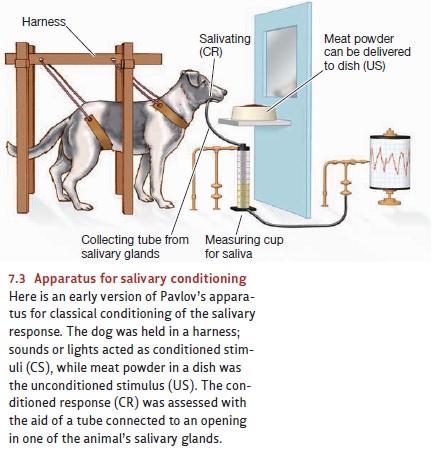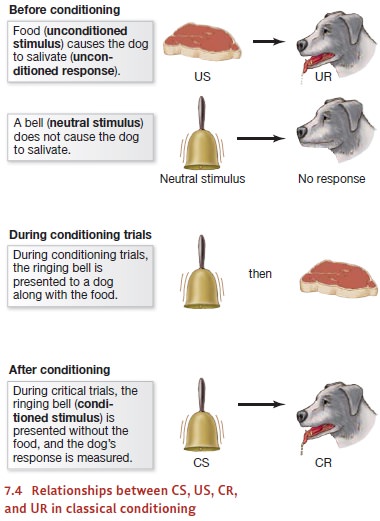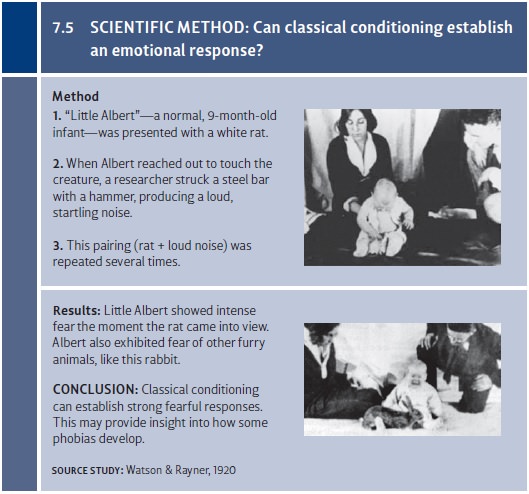Chapter: Psychology: Learning
Classical Conditioning: Pavlov and the Conditioned Response
Pavlov and the
Conditioned Response
Pavlov’s early work, for which he
earned the Nobel Prize in medicine in 1904, was not in psychology. Instead, his
research was concerned with digestive physiology, and many of his laboratory
studies focused on the secretion of saliva in dogs. Pavlov knew from the start
that salivation is triggered whenever food (especially dry food) is placed in
the mouth. During his experiments, however, a new fact emerged: Salivation
could be set off by a range of other stimuli as well, including stimuli that
were at first totally neutral. Dogs that had been in the laboratory for a while
would salivate in response to the mere sight of meat, or the sight of the dish
that ordinarily held the meat, or even the sight of the person who usually
brought the meat. Pavlov was intrigued by these effects because he realized
that in these cases, the organism seemed to be developing new reflexes and
changing its behavior in a fashion directly shaped by learning. He decided to
refocus his research program to study this learning.
In his experiments, Pavlov
created simple patterns for the animal to detect. For example, he would ring a
bell and then give the animal food. Then, after a short wait, he would present
another pair of stimuli: bell, then food. After another wait, he presented yet
another pairing: bell, then food. After several such pairings, Pavlov observed
what happened if the bell was Harnesssounded alone, without any
food being given (Pavlov, 1927;Figure 7.3). The result was clear:

The dog salivatedinresponse to the bell.To describe this pattern, Pavlov distinguished two types of responses: An unconditioned response (UR) was a biologi-cally determined reflex, triggered by a certain stimulus inde-pendent of any learning. In Pavlov’s terms, the trigger for an unconditioned response was an unconditionedstimulus(US). In the procedure described, the unconditioned stimulus(the US) is food in the animal’s mouth; the unconditionedresponse (the UR) is salivation. The linkage that makes the US and so (in Pavlov’s terms) is not a product of the learning process called “conditioning”; that’s why the stimulus and response are said to be unconditioned.
The second type of response is a conditioned response (CR), and it is a
product of learning. Like the UR, the CR is triggered by a specific stimulus,
but it’s a stimulus that was neutral at the start of learning. In our example,
this neutral stimulus is the bell, and it came to elicit the CR (salivation)
only after several presentations in which this stimulus was followed by the US
(food in the mouth). In Pavlov’s terms, the bell is a conditioned stimulus (CS)—a stimulus that’s initially neutral but
becomes associated with the US during the experiment.
The relationships between US and
UR, CS and CR, are summa-rized in Figure 7.4 and form the basis of the learning
studied by Pavlov. In his honor, this type of learning is sometimes called Pavlovian conditioning, but it’s more
commonly known asclassical conditioning.

Early research on classical
conditioning focused on one condi-tioned response—salivation by dogs—and a
narrow range of condi-tioned stimuli (the sound of bells—or in other
experiments, the ticking of metronomes). Subsequent research, however, has made
it plain that this form of learning occurs in a remarkable range of species and
circumstances. Indeed, classical conditioning can be documented not just in
humans but in species as diverse as ants and ers, cats
and cockroaches, wolves
and worms. By
using the appropriate US,
researchers have conditioned crabs to twitch their tail spines, fish to thrash
about, and octopuses to change color. Responses conditioned in studies with
humans include changes in heart rate or blood pressure (where the US is
typically a loud noise or rap on the knee) and the reflexive eye blink (using a
US of a puff of air on the open eye).
Outside of the laboratory,
classical conditioning touches many aspects of our lives. We all tend to feel
hungry at mealtime and less so in between; part of the reason is a conditioning
process in which the CS is a particular time of day and the US is the
presentation of food (which normally is paired with that time of day). Our
emotional responses to certain songs, or certain smells, or even certain social
situations can be understood in similar terms, and the response is likely to be
the result of some previous pairing between these stimuli and some emotional
experience. This type of learning is, for example, a plausible basis for some
forms of anxiety as well as some phobias (Figure 7.5). Yet another example is
sexual arousal, which can often be produced by an initially neutral word or
gesture that has—through learning—acquired an erotic association. Clearly,
then, classical conditioning is a process with wide application and great
importance.

Related Topics